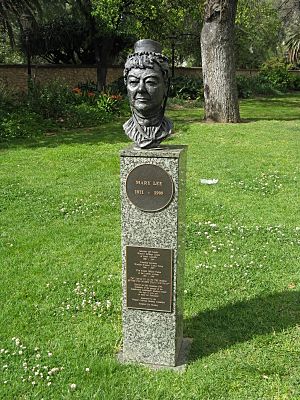Mary Lee (suffragist) facts for kids
Quick facts for kids
Mary Lee
|
|
|---|---|
 |
|
| Born |
Mary Walsh
14 February 1821 |
| Died | 18 September 1909 (aged 88) North Adelaide, Australia
|
| Years active | 1883–1896 |
| Known for | Women's suffrage in South Australia |
| Spouse(s) |
George Lee
(m. 1844) |
| Children | 7 |
Mary Lee (born Walsh) (1821–1909) was an important Irish-Australian woman who fought for women's rights in South Australia. She was a leading voice for women to gain the right to vote and for better working conditions.
Contents
Early Life in Ireland and Australia
Mary Lee was born in Ireland on February 14, 1821. In 1844, she married George Lee, and they had seven children. She even ran a school for girls in Ireland.
In 1879, Mary, who was now a widow, moved to Adelaide, South Australia, with her daughter Evelyn. They traveled on a new steamship called the Orient. Mary's son, Ben, had moved to Adelaide earlier but sadly passed away in 1880.
Fighting for Women's Rights
In 1883, Mary Lee became active in the ladies' committee of the Social Purity Society. This group wanted to change laws to improve the lives of young women. They also worked to end child labour, which meant stopping children from working in dangerous jobs.
Improving Working Conditions
The Social Purity Society also cared about the working conditions for women. After a new law was passed in 1885, the group started campaigning for workers' rights. This meant they wanted fair treatment and pay for all workers.
In December 1889, Mary Lee suggested forming a women's trade union. A trade union is a group of workers who join together to protect their rights. The Working Women's Trades Union was started in 1890, and Mary Lee was its secretary for two years.
In 1893, Mary Lee helped examine conditions in the clothing industry. She also worked with a committee that gave clothes and food to families struggling during the economic depression of the 1890s.
The Fight for Women's Vote
On July 13, 1888, Mary Lee and other groups formed the South Australian Women's Suffrage League. Suffrage means the right to vote. Mary Lee was a key leader in this league for six and a half years. She fought hard for women to get the right to vote.
Mary Lee was known for her smart and logical arguments. She used wit and humor in her letters and speeches to convince people. She believed that women, who helped support the government, should have a say in how they were governed.
Mary Lee also spoke up for working-class people. She wrote about the 1892 Broken Hill miners' strike, highlighting how the women of Broken Hill were the first large group of working women to protest against not having a voice in making laws.
Success for Women's Suffrage
Between 1889 and 1893, several attempts to give women the right to vote failed in the South Australian parliament. But Mary Lee and other groups kept pushing. They were inspired when New Zealand granted women the right to vote.
Mary Lee, the Social Purity League, and other groups traveled all over South Australia, including the Northern Territory, collecting signatures for a petition. On August 23, 1894, they presented this huge petition to the South Australian parliament. It had 11,600 signatures and was 122 meters long!
On December 18, 1894, the Adult Suffrage Bill was passed. This law gave women the right to vote and even to stand for parliament. South Australia was the first place in the world to pass such a law.
Later Life and Legacy
After women gained the right to vote, Mary Lee worked to educate them. She encouraged women to register and vote. By her 75th birthday, 60,000 women had signed up to vote. In 1895, she was asked to run for parliament, but she declined.
In 1896, she was given an honorary position as the only female official visitor to the Lunatic Asylums. During her later years, Mary Lee faced financial difficulties. She continued to write to women in other Australian states where women still did not have the right to vote.
Mary Lee passed away in 1909 from pleurisy after getting influenza. She was buried with her son Ben.
Mary Lee Close in the Canberra suburb of Bonython is named after her. In 1994, to celebrate 100 years of women voting in South Australia, Mary Lee was recognized as a national hero. A special coin was made in her honor.
Images for kids
See also
 In Spanish: Mary Lee para niños
In Spanish: Mary Lee para niños



